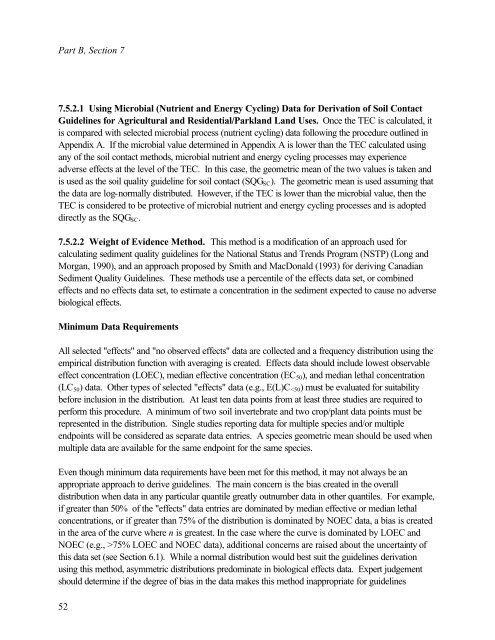Protocol for the Derivation of Environmental and Human ... - CCME
Protocol for the Derivation of Environmental and Human ... - CCME
Protocol for the Derivation of Environmental and Human ... - CCME
Create successful ePaper yourself
Turn your PDF publications into a flip-book with our unique Google optimized e-Paper software.
Part B, Section 7<br />
7.5.2.1 Using Microbial (Nutrient <strong>and</strong> Energy Cycling) Data <strong>for</strong> <strong>Derivation</strong> <strong>of</strong> Soil Contact<br />
Guidelines <strong>for</strong> Agricultural <strong>and</strong> Residential/Parkl<strong>and</strong> L<strong>and</strong> Uses. Once <strong>the</strong> TEC is calculated, it<br />
is compared with selected microbial process (nutrient cycling) data following <strong>the</strong> procedure outlined in<br />
Appendix A. If <strong>the</strong> microbial value determined in Appendix A is lower than <strong>the</strong> TEC calculated using<br />
any <strong>of</strong> <strong>the</strong> soil contact methods, microbial nutrient <strong>and</strong> energy cycling processes may experience<br />
adverse effects at <strong>the</strong> level <strong>of</strong> <strong>the</strong> TEC. In this case, <strong>the</strong> geometric mean <strong>of</strong> <strong>the</strong> two values is taken <strong>and</strong><br />
is used as <strong>the</strong> soil quality guideline <strong>for</strong> soil contact (SQG SC ). The geometric mean is used assuming that<br />
<strong>the</strong> data are log-normally distributed. However, if <strong>the</strong> TEC is lower than <strong>the</strong> microbial value, <strong>the</strong>n <strong>the</strong><br />
TEC is considered to be protective <strong>of</strong> microbial nutrient <strong>and</strong> energy cycling processes <strong>and</strong> is adopted<br />
directly as <strong>the</strong> SQG SC .<br />
7.5.2.2 Weight <strong>of</strong> Evidence Method. This method is a modification <strong>of</strong> an approach used <strong>for</strong><br />
calculating sediment quality guidelines <strong>for</strong> <strong>the</strong> National Status <strong>and</strong> Trends Program (NSTP) (Long <strong>and</strong><br />
Morgan, 1990), <strong>and</strong> an approach proposed by Smith <strong>and</strong> MacDonald (1993) <strong>for</strong> deriving Canadian<br />
Sediment Quality Guidelines. These methods use a percentile <strong>of</strong> <strong>the</strong> effects data set, or combined<br />
effects <strong>and</strong> no effects data set, to estimate a concentration in <strong>the</strong> sediment expected to cause no adverse<br />
biological effects.<br />
Minimum Data Requirements<br />
All selected "effects" <strong>and</strong> "no observed effects" data are collected <strong>and</strong> a frequency distribution using <strong>the</strong><br />
empirical distribution function with averaging is created. Effects data should include lowest observable<br />
effect concentration (LOEC), median effective concentration (EC 50 ), <strong>and</strong> median lethal concentration<br />
(LC 50 ) data. O<strong>the</strong>r types <strong>of</strong> selected "effects" data (e.g., E(L)C 75% LOEC <strong>and</strong> NOEC data), additional concerns are raised about <strong>the</strong> uncertainty <strong>of</strong><br />
this data set (see Section 6.1). While a normal distribution would best suit <strong>the</strong> guidelines derivation<br />
using this method, asymmetric distributions predominate in biological effects data. Expert judgement<br />
should determine if <strong>the</strong> degree <strong>of</strong> bias in <strong>the</strong> data makes this method inappropriate <strong>for</strong> guidelines<br />
52
















